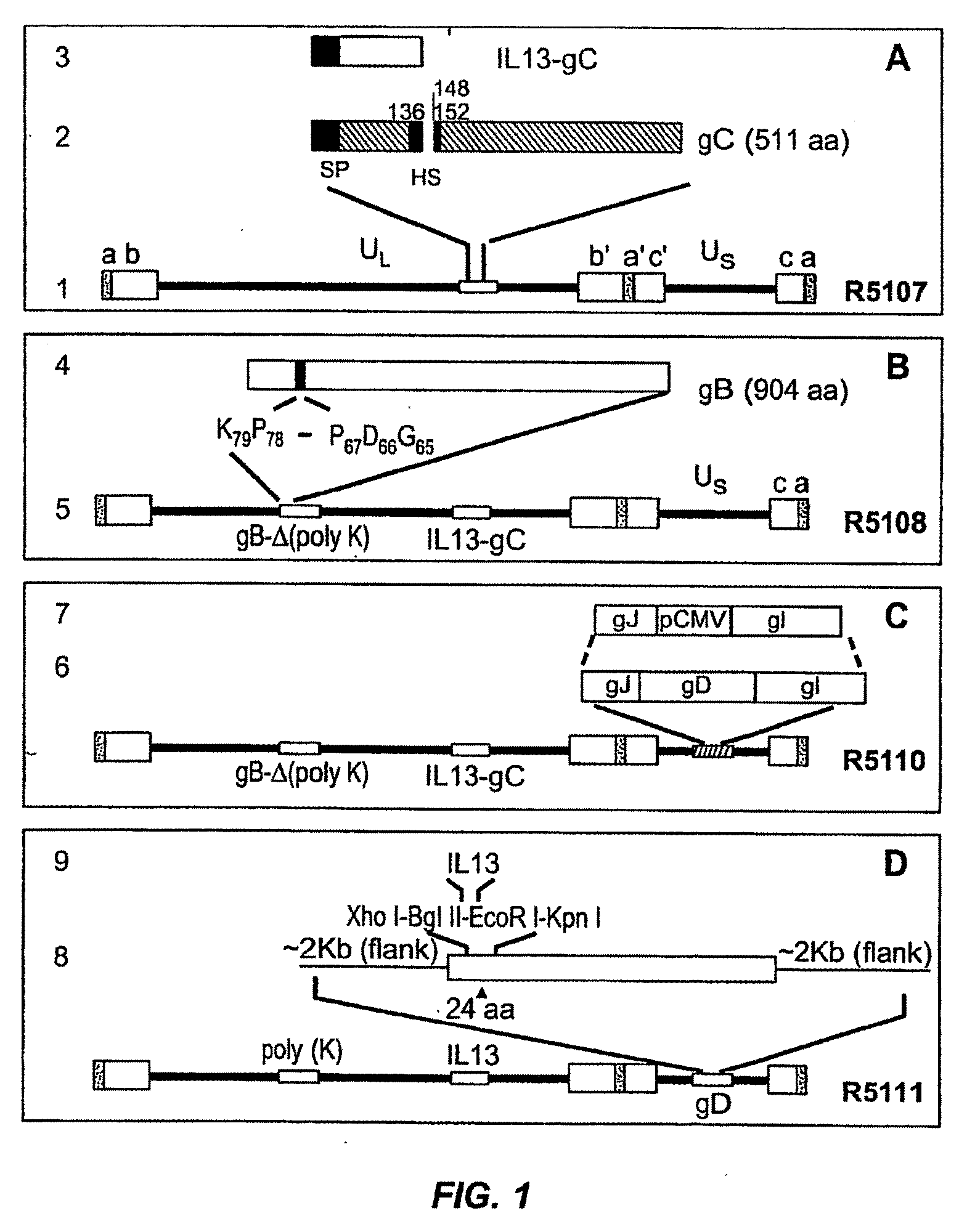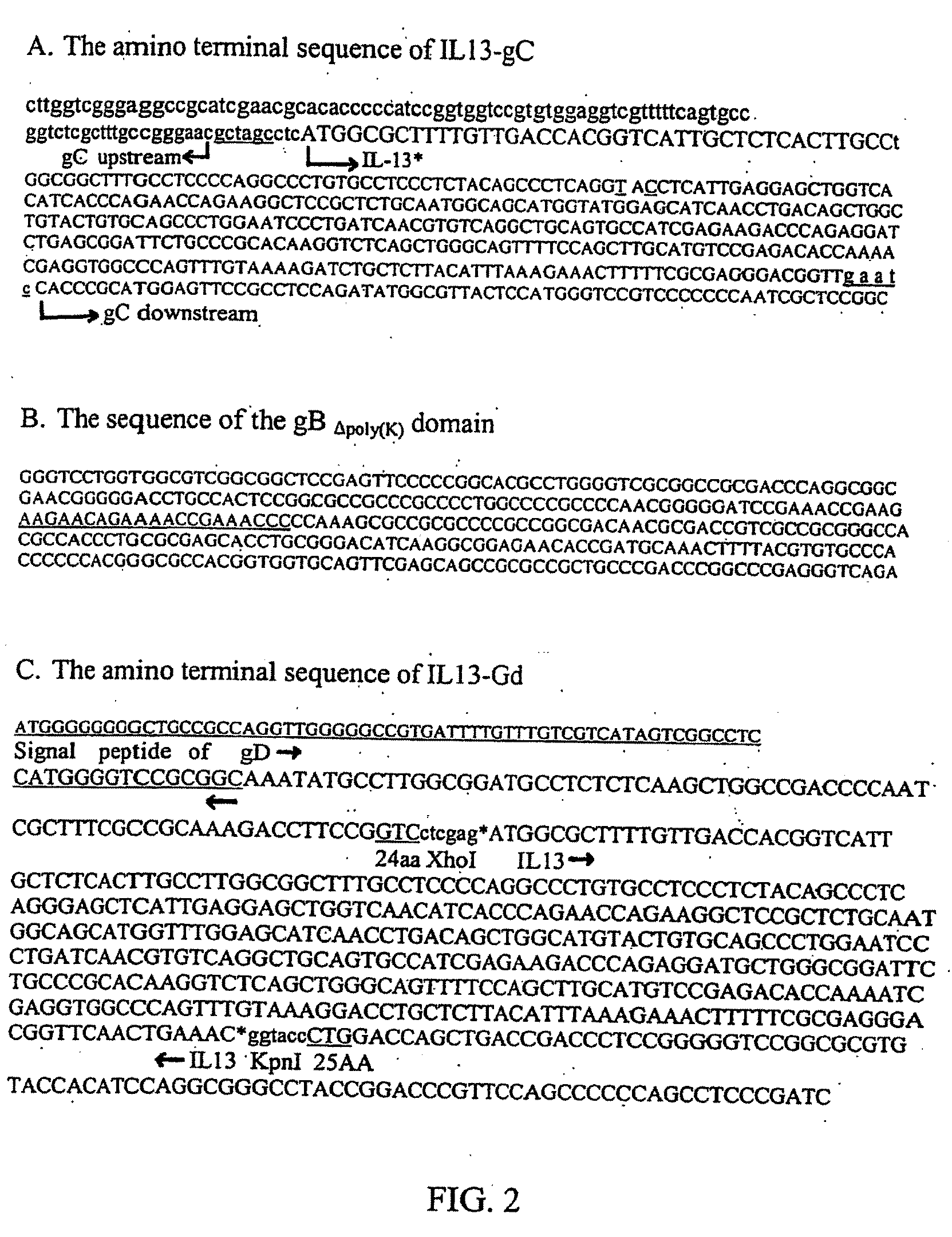Targeting of herpes simplex virus to specific receptors
- Summary
- Abstract
- Description
- Claims
- Application Information
AI Technical Summary
Benefits of technology
Problems solved by technology
Method used
Image
Examples
example 1
Construction of HSV targeting Vector R5111
[0087]A targeted HSV was constructed to target the recombinant virus to cells of malignant gliomas. The target for entry of the virus into such cells is the IL13Rα2 receptor known to be present in malignant gliomas. Unlike the more prevalent IL13αR1 receptor, the IL13Rα2 receptor has a shorter cytoplasmic domain and does not interact with IL4, of which IL13 is a close relative. In general, the construction of the targeted HSV involved mutagenizing gB and gC to preclude their interaction with heparan sulfate. Also, IL13 was inserted into gD at amino acid 24 thereby disrupting the gD binding site for HveA. The resulting IL13-gD chimeric virus can use IL13Rα2 for entry into cells carrying that receptor.
[0088]More specifically, the targeted HSV R5111 was constructed in several steps depicted in the four panels of FIG. 1 and detailed below.
[0089](i) Substitution of Amino Terminal Domain of gC with IL13 Fused to the Signal Sequence of gC.
[0090]FIG...
example 2
[0109]Construction of a Cell Line Expressing the IL13 Receptor (IL13Rα2)
[0110]A rigorous test of the ability of R5111 to utilize the IL13Rα2 protein as a receptor for entry required construction of a cell line expressing IL13Rα2 (nucleotides 126-1265 of SEQ ID NO.:33; SEQ ID NO:34) in the absence of other HSV-1 entry receptors. The J1.1 cell line was selected for this construction. In essence, this cell line lacks the receptors necessary for the entry of virus into cells and the cell line is not susceptible to infection by wild-type virus. The construction of a plasmid encoding a IL13Rα2 protein fused at its carboxyl terminus to a HA tag, transfection of J1.1 cells with the plasmid encoding the tagged IL13Rα2 protein, and selection of the cell line expressing the protein is described below.
[0111]To test for the production of IL13Rα2 protein, five clones of the selected cells were harvested, solubilized, subjected to electrophoresis in denaturing polyacrylamide gels and tested for ex...
example 3
Infection by the HSV Targeting Vector R5111
[0115]SK-N-SH, HEp-2, Vero, and U87 cells were obtained from American Type Culture Collection (Rockville, Md.) and maintained in Dulbecco's modification of Eagle's Minimal Essential Medium (DMEM) supplemented with 10% fetal bovine serum. Replicate cultures of SK-N-SH, HEp-2, Vero, U87, J1.1, and J13R were exposed to 0.01 PFU of R5111 virus per cell. After 24 hours of incubation, the cells were harvested and viral yields were titered on Vero cells.
[0116]Immunoblotting electrophoretically separated proteins. The indicated cells were mock-infected or exposed to 10 PFU of recombinant or wild-type HSV-1(F) per cell. The cells were harvested at 24 hours after infection, disrupted in SDS disruption buffer, boiled, cleared by centrifugation and electrophoretically separated on a 10% denaturing polyacrylamide gel. After transfer to a nitrocellulose membrane, the isolated proteins were reacted with antibodies as indicated using known and conventional...
PUM
| Property | Measurement | Unit |
|---|---|---|
| Time | aaaaa | aaaaa |
| Composition | aaaaa | aaaaa |
| Surface | aaaaa | aaaaa |
Abstract
Description
Claims
Application Information
 Login to View More
Login to View More - R&D
- Intellectual Property
- Life Sciences
- Materials
- Tech Scout
- Unparalleled Data Quality
- Higher Quality Content
- 60% Fewer Hallucinations
Browse by: Latest US Patents, China's latest patents, Technical Efficacy Thesaurus, Application Domain, Technology Topic, Popular Technical Reports.
© 2025 PatSnap. All rights reserved.Legal|Privacy policy|Modern Slavery Act Transparency Statement|Sitemap|About US| Contact US: help@patsnap.com



